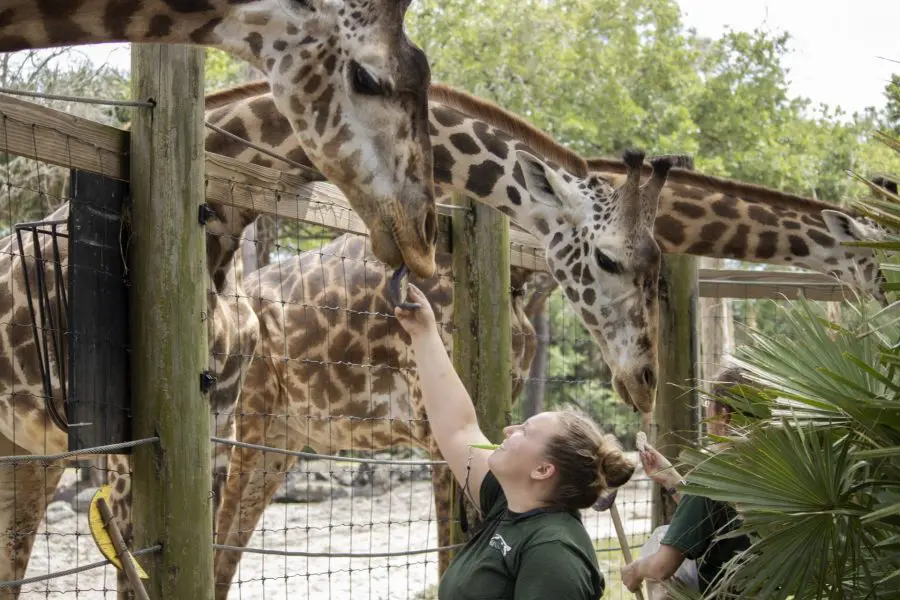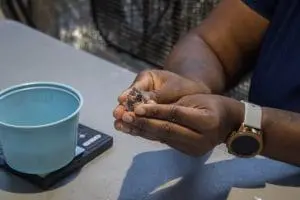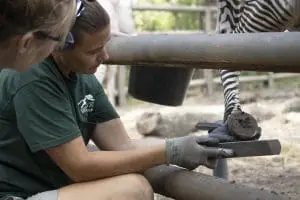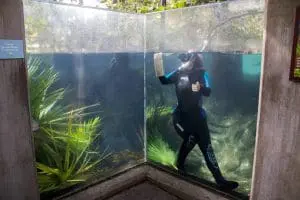

Interested in learning even more about this process? (or, just want to listen to a podcast?). Tune into our latest episode of our podcast, Paws for a Moment, which can be found on most podcasting platforms!
It’s that time again! This may not be on your radar, but it’s been on our Zoo’s radar since the start of this year: We’re applying for re-accreditation with the Association of Zoos and Aquariums (AZA)!
Our Zoo has been accredited by AZA since 1997. Accreditation isn’t a one-and-done situation, as every AZA-accredited facility needs to reapply every five years – although facilities were given a year reprieve following the initial effects of the COVID-19 pandemic.
Accreditation by AZA sets our Zoo apart as a leader among zoos and aquariums. AZA holds us accountable to maintaining high standards through ongoing evaluation of every aspect of our work – from animal wellness to education and safety to training.
While non-AZA facilities aren’t automatically “bad,” an AZA or similar accreditation can be a safeguard for guests who want to support an organization that prioritizes animal wellbeing and conservation. All AZA-accredited facilities are required to participate in conservation efforts.
 There are certain benefits available to us as an AZA-accredited facility which wouldn’t be otherwise. We can have a bigger impact on protecting our natural world by participating in AZA’s SSP and SAFE programs, which work toward not only maintaining a healthy, genetically diverse population of animals in zoos, but also supporting populations of threatened and endangered animals in their natural range. We can also connect with fellow AZA-accredited organizations, take advantage of professional development courses with AZA, and enjoy other benefits.
There are certain benefits available to us as an AZA-accredited facility which wouldn’t be otherwise. We can have a bigger impact on protecting our natural world by participating in AZA’s SSP and SAFE programs, which work toward not only maintaining a healthy, genetically diverse population of animals in zoos, but also supporting populations of threatened and endangered animals in their natural range. We can also connect with fellow AZA-accredited organizations, take advantage of professional development courses with AZA, and enjoy other benefits.
Re-accreditation is a rigorous process that requires the input of nearly every department at the Zoo, as it covers almost every aspect of running a zoo. It involves the submission of an application by September, a multi-day inspection from a team selected by the AZA in late fall or winter, and finally an in-person hearing in front of the Accreditation Commission. Read on to learn more about this process!
The Application

Our conservation breeding program for Florida grasshopper sparrows is one of the many conservation programs we have taken on over the years.
Since January of this year, our Zoo has been working on the written application. Spearheaded by our animal care team, this 30-page document quickly ballooned into hundreds of pages as they and other departments responded to the questions outlined for them and provided supporting materials. The application has several categories, including animal care, veterinary care, conservation, education, finance, governing authority, physical facilities, and safety and security.
“It’s a significant amount of paperwork,” said Lauren Hinson, our director of animal programs. “We want to make sure that we’re able to portray everything we’re doing and the improvements we’ve made, and the successes in a document, which can be hard when you’re not able to explain it.”
The questions span from the simple “Where are you located?” to “What does your enrichment program entail?” Even straightforward questions like “Do you hold the highest standards of animal wellbeing in your facility?” may start as a simple “Yes” or “No” question, but the application often includes follow-up questions to delve into the subject and ask for supporting documentation, which can be anything from photos to our standard operating procedures.
 Some aspects of the application are similar for each accreditation period. As zoos and aquariums continue to learn – especially about animal wellbeing – certain parts of the application can get more in-depth over the years. The application we’re currently working on focuses more on wellbeing for our Animal Ambassadors, the residents who star in different programs throughout the Zoo. More information has been learned about the care of reptiles in human care, how often ambassador animals can be showcased in programs, and the length of non-program time some animals may need – so the application reflects this new information.
Some aspects of the application are similar for each accreditation period. As zoos and aquariums continue to learn – especially about animal wellbeing – certain parts of the application can get more in-depth over the years. The application we’re currently working on focuses more on wellbeing for our Animal Ambassadors, the residents who star in different programs throughout the Zoo. More information has been learned about the care of reptiles in human care, how often ambassador animals can be showcased in programs, and the length of non-program time some animals may need – so the application reflects this new information.
DEAI, or Diversity, Equity, Accessibility and Inclusion, is a new section for us in the application. AZA is looking to see if applicants have an active DEAI program in place, whether it’s a person running it or a committee (our Zoo has a committee).
The application questions are open-ended and refrain from passing judgement or guiding facilities toward one way of doing things.
“A lot of them try to let facilities be unique in their own specific ways,” said animal curator Mack Ralbovsky. “We may interpret things slightly differently than another facility might, and another facility might answer something slightly differently than we do. In general, the guidelines do state the direction you need to go and what you need to uphold to accommodate those specific questions.”
 Our animal care team has made a lot of improvements in the last six years unrelated to this inspection, like the makeup of their upper management, switching habitat for animals, and revamping our Animal Ambassador program, Lauren said.
Our animal care team has made a lot of improvements in the last six years unrelated to this inspection, like the makeup of their upper management, switching habitat for animals, and revamping our Animal Ambassador program, Lauren said.
“Sometimes you can look at previous year’s application and cut and paste,” Lauren said. “Our entire application was brand new.”
The application needs to be submitted by Sept. 1, and then an inspection is scheduled!
The Inspection
Once AZA reviews all the documents, an inspection will be scheduled any time between October and January. It’s not a surprise inspection! The inspection team is made up of professionals from other facilities and often includes a veterinarian and an animal manager. The size of the team varies depending on the size of the zoo.
The inspection team will have a chance to review our current and previous applications before they come to our Zoo. This helps them pick the aspects of our Zoo they’d like more information on or take a closer look at.
 In addition, they often have their own set of questions for each area of our Zoo. Our animal care team expects the inspectors to pay special attention to the zoo’s dive program, another focus in this year’s application. Members of our Herps & Aquatics team often snorkel or free dive in our Indian River Lagoon aquarium for habitat maintenance or to set up enrichment. The inspectors may ask our Herps & Aquatics team about the Zoo’s dive protocols, emergency protocols and more.
In addition, they often have their own set of questions for each area of our Zoo. Our animal care team expects the inspectors to pay special attention to the zoo’s dive program, another focus in this year’s application. Members of our Herps & Aquatics team often snorkel or free dive in our Indian River Lagoon aquarium for habitat maintenance or to set up enrichment. The inspectors may ask our Herps & Aquatics team about the Zoo’s dive protocols, emergency protocols and more.
Sometimes, the inspectors want to learn more about a zoo’s procedures and methods on aspects of the Zoo that interest them. If Lauren were an inspector – she’d want to learn more about the facility’s hoof trim program, while Mack would want to learn more about their Animal Ambassador and Herps & Aquatics sections!
Even Zoo staff and volunteers who do not work with animal residents may face a question or two from the inspectors. These questions could cover everything from the Zoo’s mission to how to report an animal wellbeing concern. The inspectors will also have set meetings with our senior staff along with specific animal care staff.
Some minor concerns can be corrected during the inspection, but the inspectors will provide a list of their concerns, graded from least concerning to most concerning. Our Zoo will be able to offer more context to certain concerns or correct them and provide documentation showing the fix.
Our Zoo has started preparing for the inspection by doing everything from “quizzes” with our staff at large to ensure they know what they could be asked by inspectors to doing walkthroughs of all areas of our Zoo to identify any spots with debris, clutter or anything else that might be flagged. Our Zoo is always ready for any sort of inspection from the USDA or Florida Fish and Wildlife Conservation Commission.
“We’re working through this always,” Lauren said. “It’s not like we’re going crazy and doing things because AZA is coming – we do this all year long.”
Accreditation
By April 2024, our accreditation status should be set. We’re so proud to be an AZA-accredited zoo for 26 years now, and we look forward to continuing to be a part of this small group of zoos and aquariums – just 238 in the United States!
By working together with other high-caliber zoos and aquariums dedicated to saving species, we can magnify our impact for animals across the world.
Brevard Zoo is an independent, not-for-profit organization that receives no recurring government funding for our operating costs. Your generous support enables us to continue to serve our community and continue our vital animal wellness, education and conservation programs.